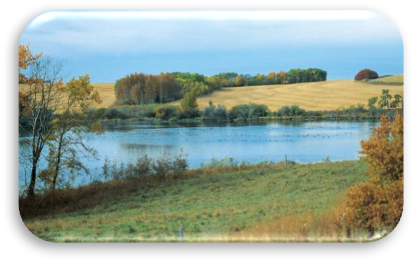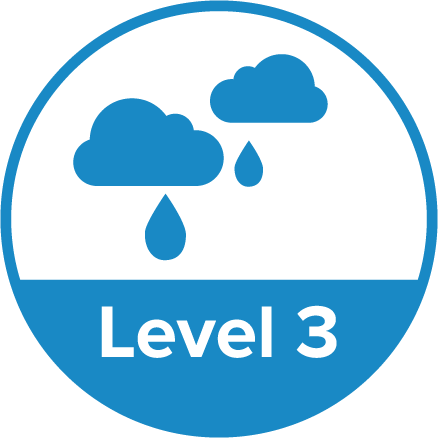 Relevancy and Engagement
agclassroom.org/la/
Relevancy and Engagement
agclassroom.org/la/
Lesson Plan
Journey 2050 Lesson 3: Water (Grades 6-8)
Grade Level
Purpose
Students will discuss the limited amount of fresh water on earth, identify how best management practices can reduce water consumption, discuss the need for water conservation and protection, and compare and contrast methods of irrigation for water conservation. Grades 6-8
Estimated Time
Materials Needed
- Water slide deck
- Engagement Activity Supplies: One-gallon container, clear bowl, ½-cup measuring cup, eyedropper
- Journey 2050: Water video
- Sustainability Farm Game Level 3: Water
- Play online or download app
- Create Free Teacher Account to track student progress and print reports on Sustainability Farming Game.
- Computer or tablet device for each student
Vocabulary
conservation tillage: farming methods that reduce the intensity or frequency of tilling in order to maintain some ground cover throughout the year and disturb the soil as little as possible while still providing the conditions needed to grow a productive crop
crop residue: plant material remaining in a field after harvesting, including leaves, stalks, and roots
irrigation: artificial application of water to the land or soil to assist plant growth
riparian area: a space between the land and the waterway ideally filled with native grass, bushes and trees
watershed: a watershed is the area of land where all of the water that falls in it and drains off of it goes into the same place
Did You Know?
- Over 70% of Earth is covered in water but only a small amount is freshwater.
- Only 5% of all the water on Earth is freshwater
- Only a small drop (3%) of the freshwater on the earth is accessible because the rest is trapped in groundwater, the atmosphere, glaciers and ice caps.10
- Groundwater is the easiest to access, but that still leaves us with over 68% of our water supply that is salt water or un-accessible.
Background Agricultural Connections
Journey 2050 takes students on a virtual simulation that explores world food sustainability and answers the question, "How will we sustainably feed nearly 10 billion people by the year 2050?" The lesson plans and online simulation program allows students to make decisions on a virtual farm and witness their impact on society, the environment, and the economy at a local and global scale. The lessons engage students with the important concepts regarding sustainable agriculture. The online simulation contextualizes these concepts as students experience the lives real farm families throughout the world. As students interact with each family, they learn the role of best management practices in feeding the world, reducing environmental impacts and improving social performance through greater access to education, medical care and community infrastructure. These lessons can be taught individually or as an entire unit. See the links below for the remaining lessons: ![]()
- Lesson 1: Sustainable Agriculture
- Lesson 2: Soil Nutrients
- Lesson 3: Water
- Lesson 4: Economies
- Lesson 5: Land Use
- Lesson 6: Careers
- Lesson 7: Technology and Innovations
- Take Action: Project-based Learning and Program Summary
Imagine a picture of the Earth. All the blue that you see is water, and it makes up 70 percent of Earth’s surface. However, we can only use a tiny fraction of it. Only 2.5 percent of Earth’s water is freshwater, found in glaciers and polar ice caps, groundwater, surface water such as lakes, ponds and rivers, and in the atmosphere. Only 0.3 percent of that is accessible for us to use.1
Water is essential, not just for drinking and keeping clean, but throughout our lives. For example, we need water to make the cars that get us to school and to grow the food that we eat. We can’t live without water. As our population grows, there is even more pressure on our limited supplies. Today, about 1.3 billion people live in regions with an uncertain supply of fresh water.2 With economic and population growth in those areas, more than half the world’s predicted population will face water shortage by 2050 if nothing is done.3 Water is essential and needs to be conserved and protected.
Water is an essential part of agriculture. In fact, nearly three-quarters of the world’s freshwater is used in agriculture to produce the food, fiber and products that we need to live.4 For example, it takes 435 liters (115 gallons) of water to grow enough wheat to make just one loaf of bread5 and about 11,000 liters (2,900 gallons) to make a pair of blue jeans.6 This calculation includes the water required to grow the raw materials, process them and manufacture the final product. As our climate changes, the weather is becoming more extreme and unpredictable. In some parts of the world, the climate is becoming drier, and in others it is becoming wetter. The unpredictable availability of water is making it harder for farmers to grow crops, putting our food supply at risk.
Through advances in technology and improved best management practices, farmers try to ensure that crops have the right amount of water while conserving water and maintaining water quality. It’s about using the right amounts at the times when crops need water most. Too little and seeds can dry up. Too much and water is wasted as runoff.
For example, in countries like Kenya where rainfall can be unpredictable, farmers collect and store rainwater to reuse when it’s needed most. They also utilize drip irrigation where water is delivered close to plant roots through a pipe, drop by drop. This minimizes water losses from evaporation and increases yields by as much as 90 percent compared to plants only receiving rainwater.7
In countries like Canada or the United States, pivot irrigation is a great way to apply water at specific times of the day. Technology plays a key role in water management. Farmers can use their phones to gain information on the soil moisture content of their crops. They can get live weather updates and calculate how much water is needed for the day. They can remotely turn their irrigation systems on and off to use water more efficiently while increasing crop yields.
Another best management practice is conservation tillage, which involves covering at least 30 percent of the soil surface with crop residues left after harvesting.8 This helps slow water movement, reducing the risk of erosion. It also provides more organic matter, improving soil health. A healthy soil will hold more moisture and grow better crops.
Landowners can also improve water quality by preserving wetland and riparian areas, which are spaces between land and the waterway, ideally filled with native grasses, shrubs and trees. These areas provide many benefits, such as helping filter nutrients that are collected as the water runs over the land; helping control water during floods; and providing habitat for animals.
Through innovations such as new seed varieties, scientists are developing crops that are more resistant to change in climates so we can grow crops even when the growing conditions are not ideal. Sharing best practices and providing everyone with the tools they need to use water more efficiently is critical. It is important that every single day of the year we all take the time and make the effort to conserve and protect our precious water supplies.
Engage
This lesson has been adapted for online instruction and can be found on the Journey 2050 eLearning site.
- Fill a one-gallon container (such as a plastic ice cream bucket) with water. This represents all the water on Earth.
- Pour one half-cup of water out of the one-gallon container and into a clear bowl. The water in the bowl represents all of the freshwater on Earth, which is less than three percent of the total water on Earth. Freshwater is found in lakes, rivers, groundwater, ice and living things. The 15 half-cups that are still in the one-gallon container represent salt water. We cannot use salt water without first removing the salt in a process known as desalination. Though research and technology are improving this process, it is still prohibitively expensive and often impractical.
- With an eyedropper, place one drop of water from the half-cup onto a small plate. This one drop represents the freshwater that is available for our use. This water is found in rivers and lakes. Explain that the rest of the water in the half-cup is deep groundwater, water bound up as soil moisture, water in living things or water in the atmosphere.
- Share the statistics found in the Did You Know? section of the lesson.
- Help students conclude from the demonstration that water is a limited natural resource. Ask, “How are water and agriculture related?” Use further guiding questions until students recognize that farmers must use a portion of our water supply to grow the crops and raise the livestock that provide our food supply. Ask students, “What practices can farmers use to conserve and protect freshwater?” Inform students that they will be learning about how water use in agriculture can be managed to provide food more sustainably for our growing population.
Explore and Explain
 Preparation: Prior to class, review the Background information, video clip, and slide deck (including the speaker notes) associated with the lesson. Review the Teacher's Guide: Getting Started document for further information to prepare for class.
Preparation: Prior to class, review the Background information, video clip, and slide deck (including the speaker notes) associated with the lesson. Review the Teacher's Guide: Getting Started document for further information to prepare for class.
Activity 1:
- Open the Water slide deck.
- Slide 3: Play the Journey 2050: Water video (5:07). Engage students with the video by asking them to discover three things: 1) How is water used in agriculture? 2) What methods do farmers use to irrigate their crops? 3) What best practices can be implemented to use water more efficiently in agriculture? (Background and discussion prompts are outlined in the steps below and in the PowerPoint notes).
- How is water used in agriculture?
- Slide 4: Ask students, “What do farmers need to grow a crop?” Use the click animations on the slide deck to display open space, fertile soil, sunshine, correct climate and seeds. Once these items have been discussed, explain that there is one more item. Without it, the crop will fail completely. Ask students what this could be. (water)
- What methods do farmers use to irrigate their crops? Describe these common methods:1
- Slide 6: Drip Irrigation—Using the picture, describe drip irrigation. Water is sent through plastic pipes that are laid along the crop rows. Tiny holes allow water to drip at the base of the plants. This method is most effective for fruit and vegetable crops.
- Slide 7: Center-Pivot Irrigation—Using the picture, describe center-pivot irrigation. This is a large sprinkling system on wheels. A line of sprinklers pivots around a center point in a field. This method of irrigation is what creates green crop circles that can be seen from a plane.
- Slide 9: Flood/Furrow Irrigation—Using the picture, describe flood or furrow irrigation. To utilize this method of irrigation, farmers dig furrows between their crop rows. Water is delivered to the top of each row using ditches or siphon hoses. The crop is irrigated as the water flows from the top to the bottom of each row.
- Slide 10: Ask students, “Besides irrigation, what other ways do farmers use water?” Allow students to offer their answers. Guide the discussion, clarifying that irrigation accounts for the majority of water use in agriculture, but water is also needed to raise livestock and to clean and sterilize facilities such as milk barns or food processing plants in order to prevent food-borne illness.

- What best practices can be implemented to use water most efficiently in agriculture?
- Help students recall the definition of best practice. Next, apply the principle to water conservation and ask for ideas of how farmers can conserve water as they grow our food and fiber.
- Slide 12: Refer back to the video clip they viewed at the beginning of the lesson. It described a practice called conservation tillage. Explain that farmers will leave crop residue (materials such as stalks, stems and seeds) in their fields without plowing it under in the fall. In the spring, they use an air seeder (device that precisely plants the seeds at equal distances and proper depth in the soil and then covers them) to plant the next crop, eliminating the need to plow the soil. Conservation tillage improves water-use efficiency in crops.
- Slide 13: Explain that a riparian area is a space between land and a waterway, ideally filled with native grasses, shrubs and trees. Landowners can improve water quality by preserving wetland and riparian areas, which have many benefits. These areas help filter nutrients that are collected as water runs over the land; help control water levels during floods; and provide habitat for animals. If possible, use a local riparian area as an example to help students understand.
- Slide 14: Explain to students that some methods of irrigation are more efficient than others. Best practices in irrigation vary by farm and crop, but they will generally enable farmers to decrease water evaporation, deliver water more directly to plant roots (eliminating water loss to other locations or from runoff), and measure precise soil moisture for exact watering.
- Slide 15: Ask students, “How can we protect and conserve water at home and in our schools and communities?” As students discuss answers, reinforce the concept that our actions affect our natural resources. Water conservation ideas include: turning off the water while brushing your teeth, using low flow toilets, using water bottles and refill stations, decreasing shower times, etc.
Activity 2: Sustainability Farm Game Level 3 Water
- Slide 16: Open Level 3 of the Sustainability Farm Game on each student’s computer or device. Explain that in this level of the game they will be farming in three countries (Kenya, India and Canada or the United States). Prepare students for the game by informing them of the following:
- In this level of the game you will primarily be managing water use. There will be a water meter on the left side of the screen that you will need to pay close attention to.
- The game is simulated for the year 2030.
- Stop when you finish farming in the last country
- Total game time is 15 minutes (5 minutes in each country)
- Slides 17–18: Once students have completed the game, use the following questions to help synthesize what they have learned:
- What were your limiting factors?
- Did you find it difficult to have enough water for your crops? Why is freshwater conservation and preservation important? How did the weather impact your crops?
- What ripple effects did you notice from your investments?
Elaborate
-
Use the following supplementary videos:
- What Is a Watershed? (1:17 min)
- Why Should You Care About Our Watersheds? (2:04 min)
-
Display a map of the world and ask students, “Which countries have the least available freshwater?” Allow students to offer their guesses and proceed to ask, “Which countries have the most available freshwater?” Discuss reasons why. Through class discussion, help students more fully recognize that across the globe not everyone has access to a reliable freshwater source. Discuss factors that impact water availability and daily water use per person (estimate liters or gallons by country). Access data from FAO website.
-
Display a map of your local watershed so students can see where water flows from and to in your area. Every action you take impacts our community and our neighbors downstream. Point out to students that in some countries they can’t drink water from the tap because it is contaminated. Every day we must protect and conserve water.
-
Have students play the Water Savers board game.
Evaluate
Summarize the following key points (slide 19):
- Water is a natural resource critical to agriculture.
- Although the majority of Earth is made up of water, only a small fraction is actually usable.
- Farmers improve their water efficiency by using water conservation practices and technologies such as irrigation (with moisture sensors), conservation tillage and riparian areas.
- Some regions of the world face greater threats to their water supply than others.
Sources
- https://www.usgs.gov/special-topics/water-science-school/science/where-earths-water
- http://www.fao.org/news/story/en/item/130033/icode/
- https://www.weforum.org/agenda/2020/06/world-population-water-stress-2050-climate-change/
- http://www.fao.org/news/story/en/item/130033/icode/
- http://www.nationalgeographic.com/kidsnetwork/water/session_01.html
- https://www.thefashionlaw.com/how-many-gallons-of-water-does-it-take-to-make-a-single-pair-of-jeans/
- http://www.borgenmagazine.com/impact-drip-irrigation-crop-per-drop/
- http://www.fao.org/docrep/t1696e/t1696e09.htm
- https://water.usgs.gov/edu/earthwherewater.html
- https://water.usgs.gov/edu/pdf/earthwherewater.pdf
- http://www.miseagrant.umich.edu/flow/pdf/U2/FLOW-U2-L3-MICHU-08-402.pdf
- http://www.ers.usda.gov/topics/farm-practices-management/irrigation-water-use.aspx
Acknowledgements
The Journey 2050 program was originally developed by Nutrien in collaboration with Calgary Stampede, Alberta Canola Producers Commission, Nutrients for Life Foundation, and Agriculture in the Classroom Canada. Authors and contributors were drawn from each of these organizations under the direction of Lindsey Verhaeghe (Nutrien) and Robyn Kurbel (Calgary Stampede.) The lessons were updated and revised in 2017 and 2022 with contributions from the original J2050 Steering Committee, the National Center for Agricultural Literacy, and the National Agriculture in the Classroom Organization.